Gabon: Energising industrial production
 En Français
En Français
With power-hungry industrial diversification the byword for Gabon’s economic development strategy, the republic’s electrical sector, which is already grappling with its existing load, will need to increase generation output well above current levels, of which estimates vary from 374 MW to 414 MW, to sustain this expansion.
In a recent interview in the local media, the former minister of energy and hydraulic resources, Régis Immongault, who is now the minister of industry and mining, indicated that the ministry hopes to increase electricity production to 1200 MW by 2020. The state’s goal is to increase the role of hydroelectric power and renewable energy resources in electricity production.
With demand growing by up to 15 MW a year – a rate which has virtually doubled earlier forecasts of 2% or 3% growth by the International Finance Corporation, causing a variety of complications for utility providers – there is certainly a need for improved generation and transmission, particularly as the country increases production in value-added secondary sectors, such as timber and mining processing. Such sectors, while increasing export values and creating jobs, are nonetheless voracious energy consumers.
Part of the challenge in meeting the increased demand from industrial customers will be in ensuring an effective transmission network. The Gabonese government has already begun laying the groundwork for an interconnected grid and has begun laying additional high-tension lines and transformers to ensure greater supply to rural areas and smaller towns.
A bigger challenge comes with ensuring adequate generation. However, Gabon’s scope for increased output is sizeable. In the hydroelectric sector, for example, which already supplies just over half of the country’s current demand, there is an estimated potential for a total production of 6000 MW if it were to be fully developed. Some 50 sites have been identified as offering scope for commercially feasible generation.
In line with this, several major electrification and energy generation projects are already under way, spearheaded by the Ministry of Petroleum, Energy and Hydraulic Resources. Amongst the largest projects relevant to industrial areas include the Grand Poubara Dam, which is expected to generate 160 MW of electricity over the first phase of the project. A second phase offers the potential to increase capacity up to an additional 240 MW. According to the ministry, the redirection of the Ogooué River and the construction of the feed tunnel are complete, and work on the power plant is under way. Construction on the dam began in 2008 and is slated to wrap up by 2013.
The government has sought to increase room for the private sector to participate as well, in a bid to reduce public expenditures and improve efficiency. In 2010, the Ministry of Energy signed a CFA124bn (€189m) public-private partnership with the Renewable Energy Development Company (Compagnie de Développement des Énergies Renouvelables, CODER) for the construction of two additional hydroelectric dams.
The “Impératrice” Dam on the Ngounié River is expected to produce at least 42 MW, for a total investment of CFA70bn (€106.8m). The power it generates will serve the mining regions of Mabounié and Ndjolé, timber transformation operations in the Moyen-Ogooué province, the cities of Mouila and Mandji in the Ngounié province, as well as Libreville and the Nkok Special Economic Zone (Zone Économique Spéciale de Nkok, ZES), one of Gabon’s largest industrial development projects.
Construction has already begun on the second hydroelectric dam, this one on the Okano River. Called “FE 2,” the dam is expected to generate a minimum of 36 MW for a total project cost of CFA55bn (€83.8m). Energy from the FE 2 will serve the industrial and mining zone of Ndjolé, as well as the northern Woleu Ntem province and Libreville. Both dams are expected to be complete in 2013.
Finally, a gas-fuelled power plant is in the final stages of construction in Alenakiri, northeast of Libreville. Developed by the Israeli firm Telemenia, half of the plant’s 70-MW output will go toward supplying the Nkok ZES, with the remainder going to Libreville.
Immongault also stated that the Ministry of Energy’s investment in power reached CFA100bn (€152m) in 2011, much of which was directed toward the development of renewable energy sources. The ministry plans a total investment of €2.29bn from 2010 to 2020 and is seeking private sector investment to accelerate progress in developing clean energy solutions.
While the government has sought to encourage new value-added industrial activities throughout the country, one of the more immediate beneficiaries of the improved energy grid will be the Nkok ZES, a joint venture with the Singaporean commodities firm Olam.
The first phase of the ZES – which targets commodity transformation activities, including timber products, scrap metal and paper – was inaugurated in September 2011 covering 393 ha. Gagan Gupta, the director-general of Olam Gabon, reported in the local press that 45 businesses have or are currently setting up operations in the Nkok ZES, and when completed, it should be able to accommodate 150 businesses.
Gupta estimated that operations in the ZES will require 220 MW of electricity – more than the current peak demand of the entire city of nearby Libreville – and which surpasses the area’s current supply. While the zone will benefit from the state-led projects to boost overall generation capacity, to complement these projects, a 15-MW power plant is planned within the ZES itself, which will use biomass from timber processing as its input.



